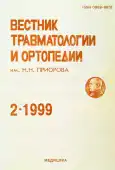Treatment of lumbar osteochondrosis by intercuteneous laser diskectomy
- Authors: Mironov S.P.1,2, Nazarenko G.I.1,2, Cherkashov A.M.1,2, Burmakova G.M.1,2
-
Affiliations:
- Central Institute of Traumatology and Orthopedics. NN. Priorov
- Medical Center of the CBR
- Issue: Vol 6, No 2 (1999)
- Pages: 19-24
- Section: Original study articles
- URL: https://journals.rcsi.science/0869-8678/article/view/104802
- DOI: https://doi.org/10.17816/vto104802
- ID: 104802
Cite item
Full Text
Abstract
Fifteen patients with lumbar osteochondrosis complicated by L4-L5 and L5-S1 disk protrusion treated by interosseous laser diskectomy are reviewed. Early and long-term results are given. In 14 patients (93%) good results were achieved, 1 patients (7%) had satisfactory outcome. Indications for intercutaneous laser diskectomy are the following: low back pain irradiating to lower extremity, and persistent over 3 months, failed conservative treatment, absence of neurologic complications, such as paresis, disturbance of pelvic organs function as well as disk protrusion (size up to 6 mm) confirmed by CT, MRI. This method does not damage soft tissues and allows to achieve persistent release of pain syndrome.
Full Text
##article.viewOnOriginalSite##About the authors
S. P. Mironov
Central Institute of Traumatology and Orthopedics. NN. Priorov; Medical Center of the CBR
Author for correspondence.
Email: info@eco-vector.com
Russian Federation, Moscow
G. I. Nazarenko
Central Institute of Traumatology and Orthopedics. NN. Priorov; Medical Center of the CBR
Email: info@eco-vector.com
Russian Federation, Moscow
A. M. Cherkashov
Central Institute of Traumatology and Orthopedics. NN. Priorov; Medical Center of the CBR
Email: info@eco-vector.com
Russian Federation, Moscow
G. M. Burmakova
Central Institute of Traumatology and Orthopedics. NN. Priorov; Medical Center of the CBR
Email: info@eco-vector.com
Russian Federation, Moscow
References
- Антонов Н.П. Заболевания нервной системы. — Минск, 1992.
- Попелянский Я.Ю. Болезни периферической нервной системы. — М., 1989.
- Юмашев Г.С., Фурман М.Е. Остеохондрозы позвоночника. — М.. 1985.
- Ascher P.W. //Abstracts Seara Medica Neurochir. — 1986. — N3. — S. 36.
- Choy D.S.J., Case R.B., Fielding W. et al. //New England J. Med. — 1987. — N 317. — P. 771-772.
- Choy D.S.J., Case R.B., Fielding W. et al. //Annual meeting of the Orthopaedic Research Society, 3rd: Abstracts. — San Francisco, 1987. — P. 19-22.
- Choy D.S.J., Ascher P.W., Saddekni S. et al. //Spine.1992. — Vol. 17, N 8. — P. 949-956.
- Choy D.S.J., Diwan S. //J. Clin. Laser Med. Surg. — 1992. — Vol. 10, N 6. — P. 435-437.
- Crawshaw C., Frazer A.M., Merriam W.F. et al. //Spine. — 1984. — Vol. 9. — P. 195.
- Ejeskar A., Nachemson A., Herberts P. et al. //Clin. Orthop. — 1983. — N 174. — P. 236-242.
- Hijikata S., Yamiagishi M., Nakayama T. et al. //Toden Hosp. — 1975. — N 5. — P. 5-13.
- Kambin P., Gellman H. //Clin. Orthop. — 1983. — N 174. — P. 127-132.
- Maroon J.C., Onik G. //J. Neurosurg. — 1987. — N. 66. — P. 143-146.
- Onik G., Helms C.A., Ginsberg L. et al. //Radiology.1985. — N 155. — P. 251-252.
- Quigley M.R., Maroon J.C. //Spine. — 1994. — Vol. 19, N 1. — P. 53-54.
Supplementary files








